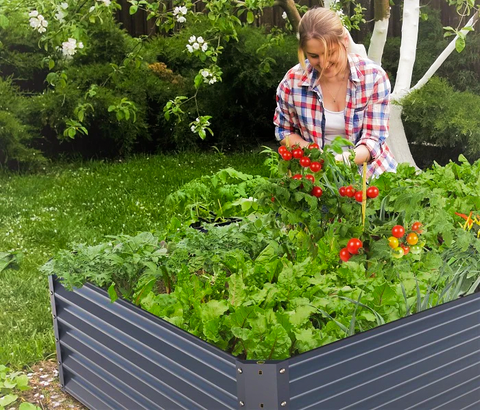Raised beds are a popular gardening technique, offering numerous benefits like improved drainage, better soil control, and reduced weed competition. However, one crucial aspect to consider when planning raised beds is the depth. Deep and shallow raised beds each have their advantages and are suitable for different types of plants. In this comprehensive guide, we'll delve into the world of raised beds and explore the factors to help you decide whether deep or shallow raised beds are the right choice for your plants. Additionally, we'll provide a list of shallow-rooted plants and deep-rooted plants to assist you in making informed decisions for your garden.

The Benefits of Raised Bed Gardening
Before delving into the depth of your raised beds, let's briefly revisit why raised bed gardening is so popular:
- Improved Soil Quality: Raised beds allow you to create the ideal soil mix for your plants, ensuring they have the nutrients they need for healthy growth.
- Enhanced Drainage: Raised beds typically drain better than traditional in-ground gardens, preventing waterlogged roots and soil.
- Reduced Weeds: Elevated soil levels in raised beds make it harder for weeds to invade, reducing the need for constant weeding.
- Extended Growing Season: The soil in raised beds warms up faster in the spring, extending the growing season and allowing for earlier planting.
- Better Accessibility: Raised beds are at a comfortable height, reducing the strain on your back and knees, making gardening more accessible to people of all ages.
Deep Raised Beds: Exploring the Depths
Deep raised beds are generally defined as those with a soil depth of 12 inches or more. These beds offer several advantages:
Pros of Deep Raised Beds
- Versatility: Deep beds can accommodate a wide range of plants, including deep-rooted vegetables, perennials, and even small trees.
- Healthy Root Development: Plants with deep root systems thrive in deep beds, as they have ample space to establish strong and healthy roots.
- Drought Resistance: Deeper soil retains moisture better, reducing the need for frequent watering during dry spells.
- Longer Crop Rotation: In deep beds, you can practice longer crop rotation, which helps prevent soil depletion and pest problems.
Cons of Deep Raised Beds
- Cost and Labor: Building and filling deep beds can be more expensive and labor-intensive due to the larger volume of soil required.
- Soil Quality: Ensuring consistent soil quality throughout the entire depth of a deep bed can be challenging and may require additional amendments.
- Excessive Depth: For some plants, especially shallow-rooted varieties, deep beds may provide more space than necessary, potentially leading to overgrowth.

Shallow Raised Beds: A Different Approach
Shallow raised beds typically have a soil depth of around 6 to 8 inches. These beds offer their unique set of benefits and drawbacks
Pros of Shallow Raised Beds
- Affordability and Simplicity: Shallow beds are more budget-friendly and easier to build and fill with soil.
- Precise Soil Improvement: It's easier to concentrate on improving the quality of the top few inches of soil, ensuring it's rich in nutrients and well-draining.
- Reduced Watering: Shallow beds retain less water, making them ideal for plants that prefer drier conditions.
- Focused Planting: Shallow beds are excellent for plants with shallow root systems, allowing you to provide them with the perfect amount of space.
Cons of Shallow Raised Beds
- Limited Plant Selection: Shallow beds are less suitable for deep-rooted vegetables, large plants, or perennials that need more extensive root space.
- Frequent Watering: The shallower soil can dry out more quickly, necessitating more frequent watering, especially in hot weather.
- Crop Rotation Challenges: Crop rotation may be limited due to the shallower soil depth and potential nutrient depletion.

Choosing the Right Depth for Your Plants
The choice between deep and shallow raised beds should align with the types of plants you want to grow. Here's a list of shallow-rooted plants and deep-rooted plants to help you decide:
Shallow-Rooted Plants
- Lettuce: This leafy green has shallow roots and thrives in shallow beds, making it an excellent choice for salads.
- Radishes: Radishes are known for their quick growth and shallow root systems, making them perfect for shallow beds.
- Spinach: Spinach has shallow roots and can flourish in beds with less depth.
- Arugula: Arugula is a shallow-rooted leafy green that does well in shallow raised beds.
- Chives: Herbs like chives have shallow roots and are ideal for shallow beds.
- Marigolds: These vibrant annual flowers have shallow roots and add color to shallow beds.
- Cilantro: Cilantro is a popular herb with shallow roots, perfect for shallow beds.
- Basil: Basil thrives in shallow beds and is a staple in many culinary gardens.
- Thyme: Thyme's shallow root system makes it suitable for shallow beds and rock gardens.
- Green Onions: Green onions have shallow roots and are perfect for small garden spaces.
Deep-Rooted Plants
- Tomatoes: Tomatoes develop deep root systems and thrive in deep beds with well-amended soil.
- Carrots: Carrots produce long taproots, making deep beds with loose, stone-free soil ideal.
- Potatoes: Potatoes grow underground and require deep beds for optimal tuber development.
- Pumpkins: Pumpkin vines have extensive root systems that benefit from deep soil.
- Eggplants: Eggplants have deep roots and do well in deep raised beds with plenty of sunlight.
- Corn: Corn has an extensive root system and requires deep beds for stability and nutrient access.
- Sunflowers: These tall flowering plants develop deep roots and are suitable for deep beds.
- Asparagus: Asparagus plants have deep, fleshy roots and thrive in deep, well-prepared beds.
- Rhubarb: Rhubarb's deep roots make it a perennial that requires deep planting.
- Artichokes: Artichokes have deep root systems and benefit from deep, well-drained soil.
Maximizing Your Raised Bed Garden
In some cases, a compromise between deep and shallow raised beds may be the best solution. Consider incorporating both types of beds into your garden design to accommodate a wide range of plants. For instance, you can reserve deep beds for your tomatoes, potatoes, and pumpkins while using shallow beds for your lettuce, radishes, and herbs.
Remember that successful raised bed gardening isn't just about the depth of your beds. Other factors, such as soil quality, sunlight, and watering practices, play essential roles in your garden's overall health and productivity. By understanding the needs of your plants and tailoring your raised beds to meet those needs, you can create a thriving garden that yields a bountiful harvest and a beautiful display of nature's splendor.









